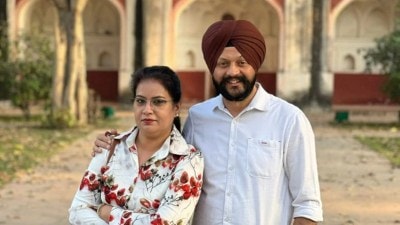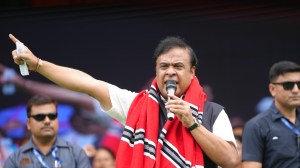Casting the first stone
Whenever she speaks her son's name, Nimeh Abu Sisseh's careworn face becomes a portrait of grief, in all its starkness and simplicity. &quo...

Whenever she speaks her son’s name, Nimeh Abu Sisseh’s careworn face becomes a portrait of grief, in all its starkness and simplicity. "Every day, I ask Allah’s mercy for him," she said, half-reclining on a thin mattress in the three-room concrete shack that is home to her extended family of 30 people. "Every day, ever since that day."
That day was December 8, 1987, when her 16-year-old son Hatem, one of a crowd of camp dwellers hurling stones and firebombs at Israeli soldiers, became the first person to die in the long and bloody Palestinian uprising against Israeli rule.
In the seven years that followed, 1,306 Palestinians were killed by Israelis, and 192 Israelis were slain by Palestinians. An additional 822 Palestinians, mainly accused of some form of collaboration with the Israelis, were killed by other Palestinians.
The uprising focused world attention on the Palestinian cause, eventually forcing both sides into peace talks that may yet lead to statehood. If not quite the birth of a nation, it brought a new sense of pride and purpose to a people demoralised by decades of displacement and occupation.
But in the chill of that December morning, no one knew the enormity of the events that had just been set in motion. Certainly not Nimeh Abu Sisseh, newly cast into a well of private pain.
At first, no one even knew what to call it. The riots in the Jebaliya camp spread quickly, flaring up elsewhere in Gaza and in the West Bank, triggering a violent Israeli response. Gradually, as the weeks and months dragged on, it became clear that the scattered fighting had coalesced into an all-out Palestinian battle for independence for the territories that Israel captured from Jordan and Egypt in the six-day war of 1967.
With that dawning realisation, an Arabic term was coined — Intefadeh — literally meaning a shaking off, but more succinctly translated as uprising. Even the Israelis adopted it.
The suffering left the lives of almost no Palestinian untouched. Prolonged school closings deprived children of education. Any activity had to be coordinated around curfews. Almost every family had a son, a father or a brother who was jailed.
Daily, the toll of dead and injured mounted: combatants and bystanders, young stone-throwers and grizzled village elders, soldiers and settlers.
Televised images of Israeli troops firing on demonstrators brought a swelling of international sympathy for the Palestinians, whose cause up until then had been associated mainly with terrorist attacks and hijackings.
In the eyes of the world, it boiled down to a classic David-and-Goliath image of boys with slingshots facing a powerful modern Army.
For all their strength and technical prowess, the Israelis learned the same bitter lesson that Americans learned in Vietnam and the Russians learned in Afghanistan: that a ragtag irregular Army — fervent, committed and fighting on home ground — can prove nearly impossible to crush.
And the Intefadeh bred a generation of Palestinians whose childhoods were shaped by violence that some proved destined to repeat.
The dozen or more young men who have blown themselves up in bombings in Israel over the past several years came of age watching older brothers do battle in the streets, seeing fathers dragged off to jail, absorbing a community ethic that glorified death in the struggle against Israel as martyrdom.
The radical Islamic group Hamas, the prime stager of suicide attacks, dates its founding to the start of the Intefadeh. With the following it built then, Hamas has lately sent clear signals it will demand a greater voice in whether Palestinians move ahead with the faltering peace process. In recent weeks, Palestinian protests in the West Bank have often boiled over into scenes eerily reminiscent of the uprising’s days of rage.
Nearly every week, in biblical towns like Bethlehem, the two sides square off. Masked Palestinian youths rise on tiptoe to hurl jagged chunks of stone. Israeli soldiers crouch behind barricades, firing stun grenades, tear gas and rubber bullets. In December of 1987, Gaza was a powder keg waiting for the spark. Poor, gritty and angry, the crowded strip — home to about half of the territories’ two million Palestinians — was a landscape of tumbledown towns and tin-shack refugee camps where the streets ran with raw sewage.
What set off the explosion was a traffic accident. A semitrailer with an Israeli at the wheel collided with a car carrying Palestinian workers home to Gaza. Four of them were killed. In Jebaliya the next day, ugly rumours flew in the crowded confines of the camp that the crash had been a deliberate attack, one that would go unpunished. Mourning turned to anger, and hundreds of residents took to the streets with bottles, firebombs and stones.
These days, Jebaliya has largely repaired a social fabric ripped apart by years of fighting. The rhythms of daily life have quieted: veiled women balance loads of vegetables on their heads, donkey-drawn carts rattle through the sandy streets. Now under Yasser Arafat’s Palestinian Authority, Jebaliya is still impoverished, but less grindingly so. Many of the camp’s homes now have telephones. There is a small public garden, a new vegetable market. More streets are paved now. But despite material gains, there is still a deep sense of disappointment with where things stand after such protracted sacrifice.
"Things are better now, of course," said Saber Shurafi, whose drugstore is only steps from where Hatem fell. "We can breathe. We can walk in the street. We can fly our flag. But Israel still hasn’t fulfilled its promises. And if it doesn’t, there will surely be violence." Fathi Hamad, now 30, was one of the angry young men of the Intefadeh, with the jail record to prove it. Now he takes a more measured view of life. "No one loves bloodshed, it’s not the nature of a human being," Hamad said. "Still, I can’t say we have what we’d hoped for. The Intefadeh was part of a long struggle, and it’s not over yet."
Photos


Sep 17: Latest News
- 01
- 02
- 03
- 04
- 05





























